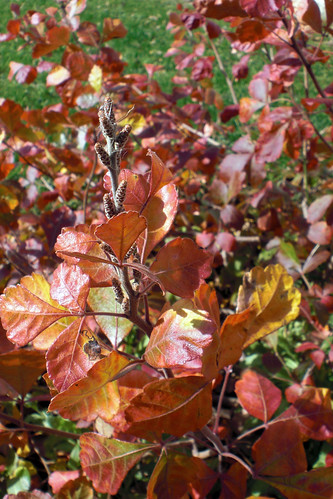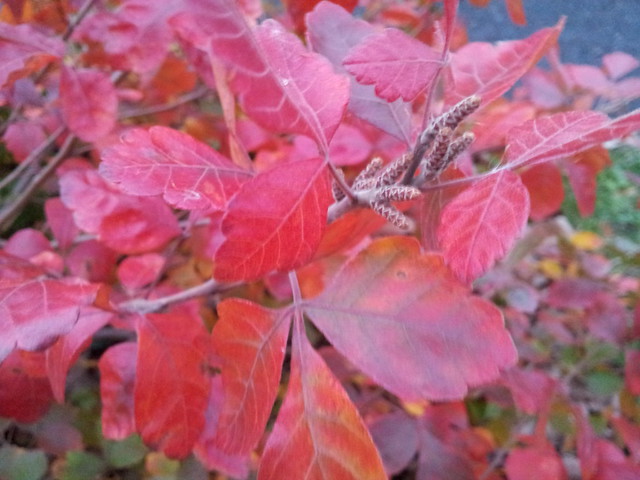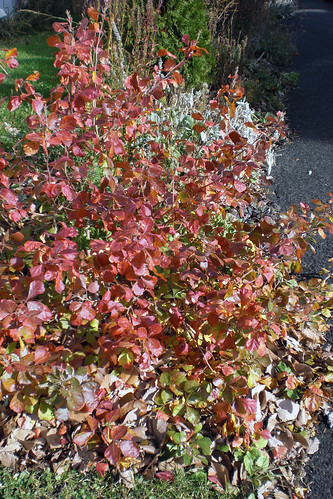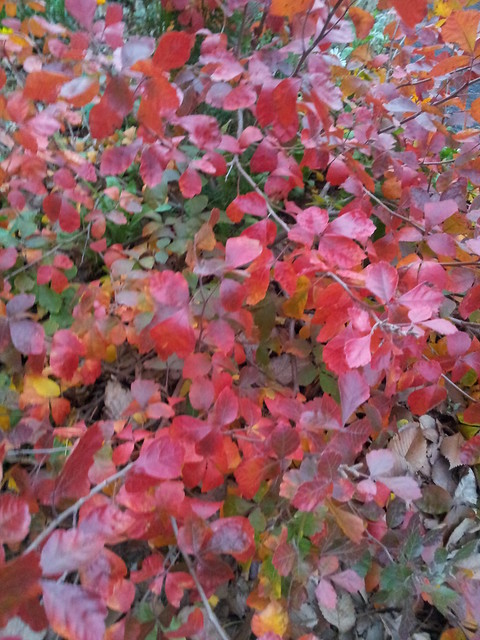I just learned of the term nativar, a phrase sometimes used to describe a cultivar selected from a native plant. Rhus aromatica 'Gro Low' is just that. It has been specially selected to clone a desired trait – in this case growing "low," or only upwards to 2 feet, from our true native Fragrant Sumac which typically reaches heights of up to 6-12 feet.
How do you know if a plant is a nativar or cultivar? Scientific botanical names should be written in italics with the genus name capitalized and the species name in lower case. The name of the cultivar should not be italicized but enclosed by single quotes following the species name. i.e Rhus (genus) aromatica (species) 'Gro Low' (cultivar). Another example is Betula nigra 'Heritage,' a familiar cultivar of the native river birch commonly available in nurseries. I also recently planted this "nativar" in my garden.
I admit, I have been careless in displaying cultivar names in some of my posts but now that I have a clear understanding of this naming system, I will make it a point to correctly display all cultivars and nativars. A good nursery will also make it a point to display plant names properly.
Are nativars the same as planting a native plant? I have heard yes and no. My experience is somewhat limited as my garden is still quite young. Nativars may be developed to produce less berries (less mess) which would defeat the purpose of planting a berry plant for me – the main reason I like to plant native is for wildlife value and berries are valuable! So, in that situation the answer would be no. But I will agree that sometimes a nativar is a better option for those of us with limited space as in the case of the Gro Low Fragrant Sumac. Its size in particular makes it a better choice to grow alongside my "Nice Driveway" as well as its preference for a well drained soil in full sun.
And as for berries? Gro Low Sumac will produce fuzzy red berries attractive to birds. Interestingly, I've read some nativars of Gro Low are monoecious, having both male and female flowers on the same plant while most are more commonly dioecious, requiring a male plant to pollinate a female plant. The male flowers are small catkins and the female flowers appear in clusters which then form berries. All I observe on mine are catkins (male), so I think mine may be an all male plant and I am now on the lookout for a Gro Low plant that displays female flowers.
In Spring both male and female yellow flowers form a delicate eye-catching haze. Gro Low is also an accepted larval host of the Red-Banded Hairstreak Butterfly. It also makes a great alternative to the invasive Burning Bush - its Fall color is fantastic! You won't have to prune it into a "cupcake," either. Mine is still putting on a great show while all the Burning Bushes in the neighborhood are now bare. Consider using this shrub as a ground cover as well. It would be a great choice for an awkward slope. Mine softens the edge of our over-sized driveway nicely.
Most of the plants selected for my garden have some type of wildlife value. Natives tend to offer the best wildlife value which is why I feature native plants in my "Going Native" posts for other gardeners to consider. Sumacs are highly valuable to wildlife but can be large or suckering so if you have a small garden, a nativar such as Gro Low Sumac offers a happy medium. I have another bird-planted (?) Sumac variety growing in my garden that I believe is truly native. It may not be the best choice for the space but hey, if it fell free from the sky, why not try. Once I'm confident that I've identified it correctly, I'll share it with you.
How do you know if a plant is a nativar or cultivar? Scientific botanical names should be written in italics with the genus name capitalized and the species name in lower case. The name of the cultivar should not be italicized but enclosed by single quotes following the species name. i.e Rhus (genus) aromatica (species) 'Gro Low' (cultivar). Another example is Betula nigra 'Heritage,' a familiar cultivar of the native river birch commonly available in nurseries. I also recently planted this "nativar" in my garden.
I admit, I have been careless in displaying cultivar names in some of my posts but now that I have a clear understanding of this naming system, I will make it a point to correctly display all cultivars and nativars. A good nursery will also make it a point to display plant names properly.
Are nativars the same as planting a native plant? I have heard yes and no. My experience is somewhat limited as my garden is still quite young. Nativars may be developed to produce less berries (less mess) which would defeat the purpose of planting a berry plant for me – the main reason I like to plant native is for wildlife value and berries are valuable! So, in that situation the answer would be no. But I will agree that sometimes a nativar is a better option for those of us with limited space as in the case of the Gro Low Fragrant Sumac. Its size in particular makes it a better choice to grow alongside my "Nice Driveway" as well as its preference for a well drained soil in full sun.
And as for berries? Gro Low Sumac will produce fuzzy red berries attractive to birds. Interestingly, I've read some nativars of Gro Low are monoecious, having both male and female flowers on the same plant while most are more commonly dioecious, requiring a male plant to pollinate a female plant. The male flowers are small catkins and the female flowers appear in clusters which then form berries. All I observe on mine are catkins (male), so I think mine may be an all male plant and I am now on the lookout for a Gro Low plant that displays female flowers.
 |
| Male Catkins |
 |
| Male Catkins |
In Spring both male and female yellow flowers form a delicate eye-catching haze. Gro Low is also an accepted larval host of the Red-Banded Hairstreak Butterfly. It also makes a great alternative to the invasive Burning Bush - its Fall color is fantastic! You won't have to prune it into a "cupcake," either. Mine is still putting on a great show while all the Burning Bushes in the neighborhood are now bare. Consider using this shrub as a ground cover as well. It would be a great choice for an awkward slope. Mine softens the edge of our over-sized driveway nicely.
Most of the plants selected for my garden have some type of wildlife value. Natives tend to offer the best wildlife value which is why I feature native plants in my "Going Native" posts for other gardeners to consider. Sumacs are highly valuable to wildlife but can be large or suckering so if you have a small garden, a nativar such as Gro Low Sumac offers a happy medium. I have another bird-planted (?) Sumac variety growing in my garden that I believe is truly native. It may not be the best choice for the space but hey, if it fell free from the sky, why not try. Once I'm confident that I've identified it correctly, I'll share it with you.



Kathy,
ReplyDeleteLove Fragrant Sumac. I use it a lot in designs and the clients always love it. Yours has exceptional fall color!
Heather
I have always admired the native sumac. This nativar is gorgeous, and I hope it becomes available in my area!
ReplyDeleteWanted a native sumac for the garden but will also try this as space is limited. I am also trying to get better and labeling plant names correctly and just read how to do this as well..I think using nativars is great when we can't find a native or space is limited.
ReplyDeleteI, too, try and plant natives because I want to attract wildlife. I am so happy to see that native plants are being called out as such.
ReplyDelete